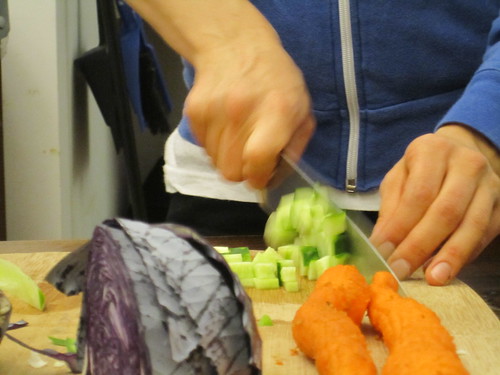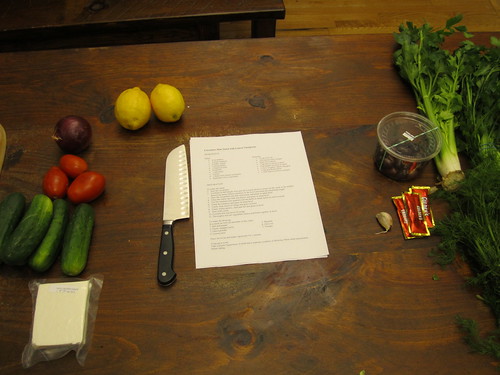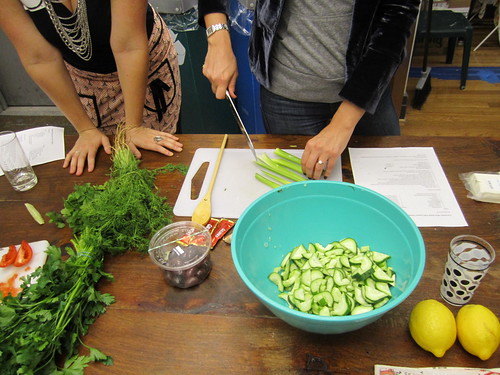As an educator I think it’s important to have new learning experiences and do things that are out of your comfort zone. It helps me remember what the students I teach in the museum might feel like upon entering the space for the first time and being unfamiliar with the works of art they will see. In search of these new experiences, David and I teamed up to have an educative after work adventure to November’s installment of the Community Cooking Club.

Community Cooking Club is a monthly “lateral learning” project set up by Tracy Candido, a social practice artist and producer who uses food as a medium to bring people together around artistic and learning initiatives. She is also a museum educator and programmer. The way Community Cooking Club works is that Tracy invites a guest chef to come up with a theme, 8 recipes and lead that evening’s workshop. There are several caveats: The recipes must be able to be prepared within an hour, they must be mostly vegetarian to accommodate a variety of diets and budgets, they must be simple enough for beginners but intriguing enough for experts. Ingredients are procured and laid out ahead of the workshop along with the print out of the recipe. When the evening’s 15 to 20 participants arrive they break into groups of 2 to 3 and choose a recipe to prepare. After an hour (or an hour and a half) of a frenzy of cooking dishes are laid out and everyone enjoys the meal. After the workshop Tracy sends the recipes out to all the participants, who have hopefully gained the confidence and familiarity with them to feel that they could prepare them by themselves at home.

Recipe laid out with tools and ingredients
One of the best parts of the workshop is that there is no actual instruction. The guest chef gives an introduction to the evenings theme and the recipes and then let’s everyone go to work while he or she circulates around to help and answer questions. Participants figure out tough parts on their own and help each other, often experienced cooks teaming up with those who prefer to microwave meals from Trader Joe’s. For example, I love to cook, but David warned me, “This is all new to me.” A communal cooking environment was new to me too and before the workshop I felt the nervous excitement I feel before teaching. That is the crux of lateral learningthat people with varying experience teach, and learn from, each other.

Chopping and sharing ideas
So what does this worthy project have to do with museum education? As we were figuring out the best way to dice and roast a pumpkin for our pumpkin bibb salad (the recipe was by this month’s guest chef Cathy Erway) David whispered to me, “I know this is a radical learning environment, but it doesn’t seem radical to me.” I agreed, because in many ways I think that the ideas of Community Cooking Club reflect best practices of gallery-based, museum education. For example:
Value the experiences and expertise that everyone brings. While museum visitors may or may not have expertise with the subject you are covering on your tour they all have something valuable to contribute and can learn from each other.
Museum educators, like the guest chef at Community Cooking Club, are there to structure, facilitate and guide visitors’ museum experiences, but not dictate them.
Learners enjoy social learning experiences. In addition to being learning spaces and repositories for history and culture museums are social spaces. Museum educators can use this to their advantage when creating informative, enjoyable learning experiences.
Learners will take risks if they are in a structured, safe environment. For example, at the Community Cooking Club many non-cooks felt safe cooking because they were given structure, clear instruction and support. They were impressed with what they could make and learned that cooking was not so hard and scary. Museum educators have the opportunity to assist visitors in discovering what they already know, trusting their knowledge, and learning how to get more information in a museum setting. Museum educators have the opportunity to make visitors feel empowered to think deeply about works of art, ask questions, and learn more.
I should note here at the end that these ideas have been influenced very much by the work of researchers John Falk and Lynn Dierking and their books such as Learning From Museums.
How do you empower visitors or students in a social learning environment?



One Response to Teaching, Cooking, and Lateral Learning